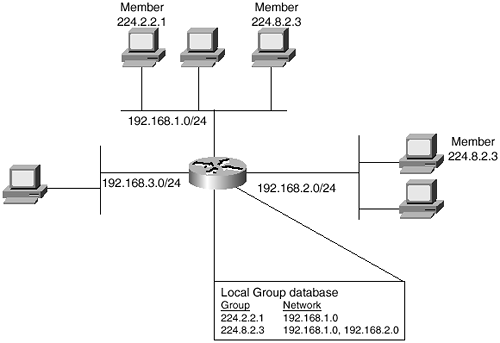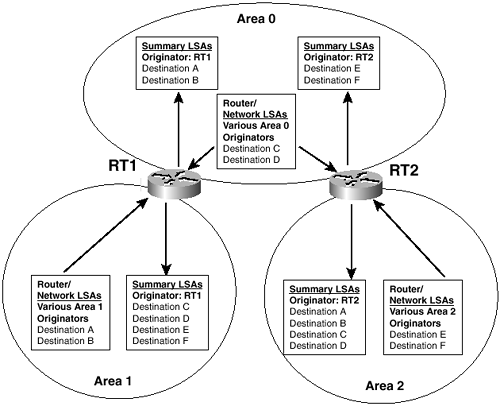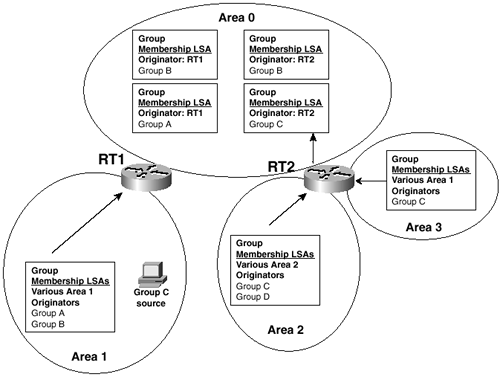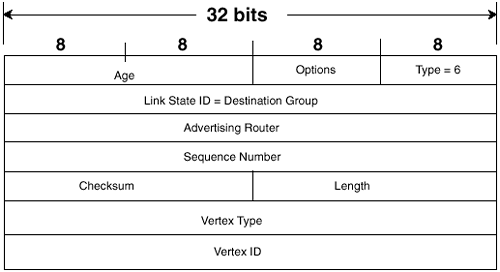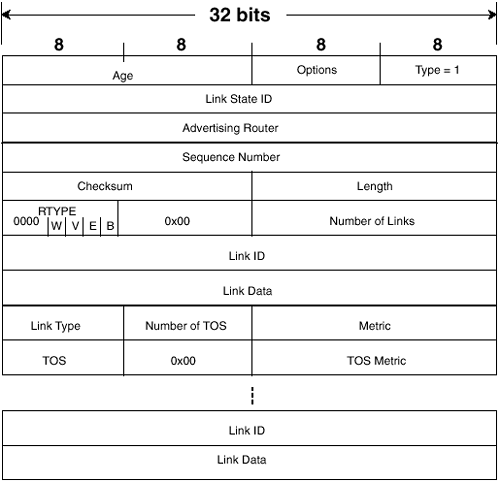Operation of Multicast OSPF (MOSPF)
| Multicast OSPF (MOSPF) offers an improvement over DVMRP in two aspects. First, it is a link-state protocol, whereas DVMRP is distance vector. That difference carries with it all the usual advantages of link state over distance vector: better convergence properties, better loop avoidance , and less periodic control traffic. The second improvement is that MOSPF is more scalable in a dense environment. This is partly due to its link-state algorithms, but also to the fact that MOSPF uses explicit joins rather than implicit joins via flood-and-prune. Multicast OSPF is not a separate protocol from OSPF, but rather is an extension of that protocol, as indicated by the name of the RFC describing it.[10] Three extensions to OSPF are defined to support multicast. First, a new LSA is defined, called the Group Membership LSA. Group Membership LSAs are LSA type 6. The Options field is extended to include a flag, called the MC bit, which is used to indicate support for IP multicast. The Options field, described in Chapter 9 of Volume I, is carried in OSPF Hello and Database Description packets and in all LSAs. The implication of the MC bit is that OSPF and MOSPF routers can be intermixed in the same internetwork, with the MOSPF routers using the MC bit to indicate their multicast support. Routers with mismatched MC bits still become adjacent. However, only neighbors whose MC bits are set in their Database Description packets exchange Group Membership LSAs during their database synchronization process. And only LSAs with the MC bit set are used in the calculation of multicast shortest- path trees. Finally, the rtype field of the Router LSA is extended to include a flag called the W bit. This flag indicates that the originating router is a wildcard multicast receiver. Wildcard multicast receivers are defined in the section " Inter-Area MOSPF." Just as unicast OSPF uses a Dijkstra-based SPF algorithm to calculate shortest-path trees to unicast destinations, MOSPF calculates trees from multicast sources to multicast destinations. Both unicast trees and multicast trees are calculated from the same link-state database. A difference, however, is that whereas the unicast SPF trees are rooted at source routers, multicast SPF trees are rooted at source multicast subnets. MOSPF BasicsThe best place to begin describing MOSPF is at a local multiaccess medium to which a group member is attached. Like unicast OSPF, MOSPF elects a designated router and a backup designated router. All attached MOSPF routers should run IGMP on the local link to discover group members , but only the DR sends IGMP membership queries and listens for IGMP membership reports . Recall from Table 5-4 that MOSPF uses explicit joins. When a group member sends an IGMP message indicating that it wants to join a group, the MOSPF DR creates an entry in its local group database. The local group database entry records the group and the attached network on which the group member resides. For example, the router in Figure 5-33 has three attached subnets, and there are three multicast group members on two of those subnets. Two of the group members, on separate subnets, belong to the same group. The router has to know only the groups and subnets on which the groups have members; it does not need to know each individual group member. Figure 5-33. The Local Group Database Records Attached Groups and the Subnets on Which the Group Members Reside The DR then originates a Group Membership LSA for each attached group. The LSA specifies the group address and the originating router ID and lists all the router's attached networks on which members of the group reside. In some cases, the router itself may run multicast applications that make it a group member. The LSA includes a Type field in which the router can indicate that it is advertising itself as a group member. The LSA is then flooded throughout the originating router's area. The Group Membership (type 6) LSA is similar to a Network (type 2) LSA in two regards:
The objective of the LSA flooding is to ensure that all MOSPF routers in an area have a copy of all Group Membership LSAs originated in the area. As with unicast OSPF, all MOSPF routers in an area must have identical link-state databases. The only difference between an OSPF link-state database and an MOSPF database in a given area is the inclusion of the type 6 LSAs. With synchronized databases, every MOSPF router in an area can calculate the same shortest path tree. The tree is rooted at the source network and has branches extending to every network containing a group member. However, the tree is not calculated immediately. Instead, it is calculated "on-demand," when the first multicast packet for the group arrives. This makes sense, because although the synchronized routers know where all destinations are, they may not yet know where the source is. The SPF calculation knows where all routers with attached group members are based on the Group Membership LSAs. And it knows where the source is located based on the source and destination addresses of the first arriving packet for the group. The regular unicast Router and Network LSAs whose MC bits are set are then used to calculate the least-cost paths from the source to each destination. The great advantage of the Group Membership LSA-based explicit joins, coupled with the on-demand SPF calculation, is that routers already know the location of the destination networks before the calculation is performed. So unlike flood-and-prune protocols such as DVMRP, packets are never forwarded to all parts of the routing domain. You might say that the MOSPF tree comes "prepruned." Based on the results of the SPF calculation, entries are made into each router's multicast forwarding table. The shortest-path tree is loop-free , and every router knows which interface is the upstream interface and which interfaces are downstream interfaces. Therefore, no RPF check is required, as it is with DVMRP. The forwarding table entry for a particular (S, G) pair indicates what upstream neighbor a matching packet should be received from and what downstream neighbors the packet must be forwarded to. The local group database also is used to make entries into the forwarding table for locally attached networks containing group members. Keep in mind a few caveats about MOSPF. First, although unicast OSPF supports equal-cost multipath, MOSPF does not. The MOSPF shortest-path tree describes a single path between the source and all networks containing group members. Second, if OSPF and MOSPF routers coexist on the same multiaccess network, care must be taken to ensure that the MOSPF router is elected the DR. If an OSPF router becomes the DR, no Group Membership LSAs are originated for any group members on the network, and consequently no multicast packets for the group are forwarded to the network. Finally, an MOSPF router must clear its entire forwarding table and recalculate its shortest-path trees if the topology within the MOSPF domain changes. Therefore, it is important that the domain be as stable as possible. Inter-Area MOSPFThe preceding section described how MOSPF behaves when the source and all group members are within the same area. Emphasis was placed on the fact that a Group Membership LSA is not flooded outside of its originating area. So what happens when group members are in one or more areas different from the source? You know from Chapter 9 of Volume I that inter-area OSPF communications is managed by Area Border Routers (ABRs). ABRs are members of the backbone area and one or more nonbackbone areas. They learn all the destinations within each attached area via Router and Network LSAs, just as any other router in the area does. ABRs then create Network Summary (type 3) LSAs, which advertise the destinations in one attached area into the ABR's other attached areas. Like type 1 and type 2 LSAs, type 3 LSAs are never flooded outside of the area in which they are originated. When an ABR receives a Network Summary LSA across the backbone area from another ABR, it creates its own Network Summary LSA to advertise that information into its attached nonbackbone areas. Figure 5-34 illustrates conceptually how ABRs use types 1, 2, and 3 LSAs. Figure 5-34. Unicast OSPF ABRs Use Network Summary LSAs to Advertise Destinations Learned from One Attached Area into Other Attached Areas MOSPF ABRs are perversely called inter-area multicast forwarders. There are both similarities and differences with the way unicast ABRs operate . An inter-area multicast forwarder knows what groups have members in each of its attached nonbackbone areas based on the Group Membership LSAs it has received in those areas. For each known group, the forwarder creates a new Group Membership LSA and floods the LSA into the backbone, as illustrated in Figure 5-35. So far, this behavior is very similar to the way an ABR uses type 3 LSAs to summarize information learned from type 1 and type 2 LSAs into the backbone. Figure 5-35. Inter-Area Multicast Forwarders Use Group Membership LSAs to Advertise the Presence of Group Members in Their Nonbackbone Areas to the Backbone Area Here the similarity to unicast ABRs ends. Unlike the way in which type 3 LSAs are used, an inter-area multicast forwarder does not send type 6 LSAs into a nonbackbone area to advertise the presence of groups outside the area. In Figure 5-35, for example, RT1 receives the type 6 LSA originated by RT2, advertising group C, but it does not create a type 6 LSA to advertise group C into area 1. The result is that an SPF tree is calculated in the backbone for each group, and the tree's branches extend to the inter-area multicast forwarder of each area containing group members. The nonbackbone areas have no knowledge of group members outside of their own area. If the source for group C in Figure 5-35 is located in area 1, however, how do its packets reach members in areas 2 and 3? The answer is a wildcard multicast receiver. These devices advertise themselves by setting the W bit in the rtype field of their Router LSAs. Within an area, multicast traffic is always forwarded to all wildcard multicast receivers. In nonbackbone areas, an inter-area multicast forwarder (a multicast ABR) is always a wildcard multicast receiver. When the source for group C in Figure 5-35 originates a group C packet, the packet is forwarded to RT1, the wildcard multicast receiver for area 1. RT1 also is a member of the backbone area, and so has calculated a shortest-path tree to all inter-area multicast forwarders whose attached areas contain members of group C. Seeing that RT2 is advertising group C members, the packet is forwarded to that router across the backbone. RT2, as a member of areas 2 and 3, has calculated separate SPF trees for group C in each area and forwards copies of the packet to the group C destinations. NOTE If there were any group C members in area 1, a copy of the packet would, of course, be forwarded over the local SPF tree to those members in addition to being forwarded to RT1. Note that wildcard multicast receivers are unnecessary in the backbone area for intradomain traffic. For every group in the MOSPF domain, an SPF tree is calculated in area 0. The branches of the tree lead either to group members located in that area or to inter-area multicast forwarders attached to other areas. So if a source is located in the backbone area, its packets can be forwarded along the correct tree. Inter-AS MOSPFRFC 1584 provides for the routing of multicast packets into and out of an MOSPF domain. You know from Chapter 9 of Volume I that a router redistributing routes into an OSPF domain from some other routing protocol is called an Autonomous System Boundary Router (ASBR). An ASBR uses AS-External (type 5) LSAs to advertise destinations outside of the OSPF domain and ASBR Summary (type 4) LSAs to advertise their own location. These LSAs are flooded into all areas of the OSPF domain, with the exception of stub areas. A router that connects an MOSPF domain to some other multicast routing domain (most likely DVMRP presently, and possibly some multicast EGP in the future) is called an inter-AS multicast forwarder. These routers behave very similarly to inter-area multicast forwarders. To forward multicast packets to destinations outside of the MOSPF domain, inter-AS multicast forwarders set the W bit in their Router LSAs and become wildcard multicast forwarders. When the routers are forwarding packets into the MOSPF domain from external sources, they become "proxy sources," with their external link serving as the root for the group's SPF tree. Like ASBRs, inter-AS multicast forwarders can be located in any area. Notice, however, that wildcard multicast forwarding capability is signaled by the W bit of type 1 LSAs, and type 1 LSAs are not flooded outside of an area. If the inter-AS forwarder is located in area 0, this is not a problem; the inter-area multicast forwarders already pull all multicast traffic to the backbone. If the inter-AS forwarder is located in a nonbackbone area, however, that area's inter-area forwarder also must become a wildcard forwarder for the backbone area. Therefore, it is recommended that inter-AS multicast forwarders be located only in area 0. It is also recommended that inter-AS forwarders be placed carefully within the MOSPF domain. Because all multicast traffic within the domain is forwarded to these routers, links leading to the routers can easily become congested . MOSPF Extension FormatsThis section describes only the formats of the multicast extensions to OSPF. For a complete description of all OSPF packets and LSAs, see Chapter 9 of Volume I. Group Membership LSA FormatThe Group Membership LSA carries the standard LSA header and has a type number of 6. Figure 5-36 shows the format for the Group Membership LSA. Only MOSPF-designated routers originate Group Membership LSAs. Notice in the format that no metric is associated with this LSA. Figure 5-36. The MOSPF Group Membership LSA Format The fields for the Group Membership LSA are defined as follows :
Extended Router LSA FormatFigure 5-37 shows the format of a Router (type 1) LSA that has been extended to support MOSPF. The format is identical to the format shown in Figure 9.55 of Volume I, with the exception of the addition of the W bit in the rtype field. The W bit is set by inter-area and inter-AS multicast forwarders to indicate to other MOSPF routers in an area that they are wildcard multicast forwarders. Figure 5-37. The Router LSA Format, with the W Bit Added to the rtype Field for MOSPF Support Extended Options Field FormatThe Options field, shown in Figure 5-38, is a part of all OSPF Hello and Database Description packets and a part of the header of all LSAs. The other flags of this field are described in Chapter 9 of Volume I, but the pertinent flag for this chapter is the MC bit. When set, this bit indicates that the originating router is multicast-capable. Figure 5-38. The Options Field Format The MC bit in Hello packets does little more than signal multicast capability. Two routers will still become adjacent, even if one sets the MC bit and the other does not. The real use of the MC bit comes into play with the Database Description packets and with LSAs. During database synchronization, an MOSPF router will send the type 6 LSAs in its database to its neighbor only if the neighbor's DD packets have the MC bit set. Likewise, only LSAs with the MC bit set are used in the MOSPF SPF calculation. |
